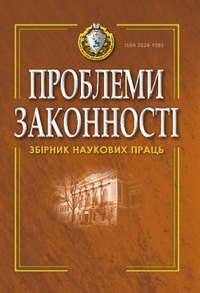Research of the source of comparative historical and legal analysis: issues of methods
DOI:
https://doi.org/10.21564/2414-990x.142.143542Keywords:
comparative historical and legal research, methodology, source-study analysis, a historical source, criticism of sources, falsification of sources, source translationAbstract
The study of collected historical sources within the framework of comparative historical and legal research provides, first of all, procedures for their external and internal criticism, verification of sources for falsification, and the delimitation for the application of translated historical and legal documents.
External criticism of the source is an analysis of the document appearance: paper, handwriting, determination of the time of origin and the circumstances of the appearance of one or another source. Internal criticism establishes its purpose, content, theme, task. It is necessary not only to know about the text, language and terminology, but also to reveal the ideological scheme, practical goals, political tendency of the document. External and internal criticism of the sources, in its essence, is an research of their form and content.
Methods for counterfeits identification and critical analysis are closely related to the external and internal criticism. According to the methodology of comparative historical and legal research, the problem of forged documents is extremely important and topical. Any objects of historical and legal comparison are based on certain historical and legal monuments. Ignoring the problem of the existence of a large number of false historical documents and, consequently, the failure of the comparative researcher to identify at the early stage of his work a forgery among the main sources of the research leads to a complete loss of his scientific value. That is why a comparative historian is obliged to have basic general knowledge in the methodology and technique of forged historical and legal documents identification.
During the comparative historical and legal analysis there is often a need to use translated historical sources due to ignorance of the original language of the historical document. In this context, it is important to understand that not all translated historical sources are equivalent. It's one thing when it comes to professional translation done nowadays, the other is when translation is a heritage of other historical eras. If in the first case, it is necessary only to be convinced of the professional interpreter skills that in principle is not particularly difficult to do in the modern conditions of the information society, in another, it is necessary to conduct additional methodological work.
References
Barton, V.I. (1978). Sravnenie kak sredstvo poznanija. Minsk: Izd-vo BGU [in Russian].
Bykovskij, S.N. (1931). Metodika istoricheskogo issledovanija. Leningrad: GAIMK [in Russian].
Damirli, M.A. (2002). Pravo i istorija: jepistemologicheskie problemy (Opyt kompleksnogo issledovanija problem predmeta i struktury istoriko-pravovogo poznanija). St. Petersburg: Izd-vo S.-Peterb. un-ta [in Russian].
Damirli, M.A. (2003). Specifika istoriko-pravovogo poznanija i novyj oblik istoriko-pravovoj nauki. Aktual'ni problemy polityky, issue 16, 416–424 [in Russian].
Koval'chenko, I.D. (2003). Metody istoricheskogo issledovanija. Moscow: Nauka [in Russian].
Kolomijcev, V.F. (2001). Metodologija istorii (Ot istochnika k issledovaniju). Moscow: «Rossijskaja politicheskaja jenciklopedija» (ROSSPJeN) [in Russian].
Langlua, Sh.-V., Sen'obos, Sh. (2004). Vvedenie v izuchenie istorii. 2-e izd. Moscow: Gos. publ. ist. b-ka Rossii [in Russian].
Lappo-Danilevskij, A.S. (2007). Ocherk russkoj diplomatiki chastnyh aktov. St. Petersburg: Izd-vo «Severnaja zvezda» [in Russian].
Lihachev, D.S. (2001). Tekstologija (na materiale russkoj literatury X-XVII vv). St. Petersburg: Aletejja [in Russian].
Melnyk, L.H. (1977). Predmet i metodolohiia istorychnoi nauky.Kiev: Vyd-vo «Vyshcha shkola» [in Ukrainian].
Pronshtejn, A.P. (1971). Metodika istoricheskogo issledovanija. Rostov-na-Donu: Izd-vo Rost. un-ta [in Russian].
Pushkarev, L.N. (1975). Klassifikacija russkih pis'mennyh istochnikov po otechestvennoj istorii. Moscow: Izd-vo «Nauka» [in Russian].
Saar, G.P. (1930). Istochniki i metody istoricheskogo issledovanija. Baku: Izd-vo AzGNII [in Russian].
Cvajgert, K., Ketc, H. (2000). Vvedenie v sravnitel'noe pravovedenie v sfere chastnogo prava. (Vols. 1–2); Vol. 1: Osnovy. Moscow: Mezhdunar. otnoshenija [in Russian].
Downloads
Published
How to Cite
Issue
Section
License
Copyright (c) 2018 Денис Анатолійович Шигаль

This work is licensed under a Creative Commons Attribution 4.0 International License.










